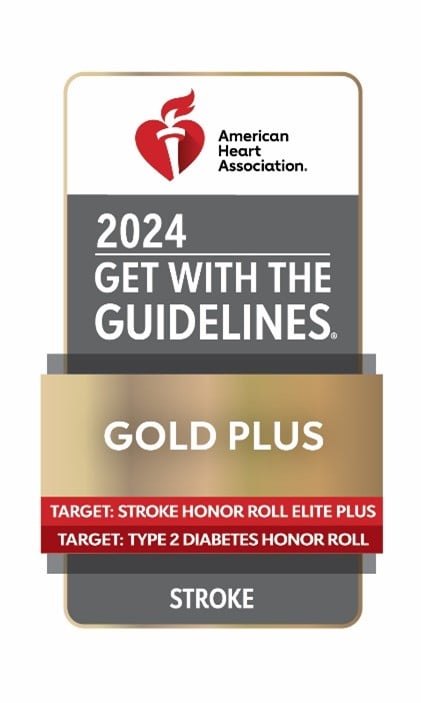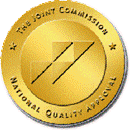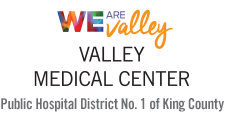Stroke & Neurovascular Care

Valley Medical Center offers a comprehensive approach to stroke care, from early intervention treatments in the Emergency Department to inpatient and outpatient rehabilitation services to help patients regain function and independence. Providing acute care, rehabilitation and education for patients and their loved ones.
Valley Medical Center Receives American Heart and Stroke Association’s Highest National Recognitions for Stroke Treatment & Care
 Valley Medical Center is nationally recognized for achievement in stroke treatment. For multiple years, we have been the recipient of the American Heart Association and American Stroke Association’s Get with the Guidelines Gold Plus Quality Achievement Award. The award recognizes VMC’s commitment and success in implementing excellent care for stroke patients, according to evidence-based guidelines.
Valley Medical Center is nationally recognized for achievement in stroke treatment. For multiple years, we have been the recipient of the American Heart Association and American Stroke Association’s Get with the Guidelines Gold Plus Quality Achievement Award. The award recognizes VMC’s commitment and success in implementing excellent care for stroke patients, according to evidence-based guidelines.
In addition to the Get with the Guidelines award, VMC has also been recognized as a recipient of the association’s Target: Stroke Honor Roll Elite Plus, for improving stroke care. This Honor Roll designation is the AHA/ASA’s highest distinction awarded for Valley’s achievement in delivering IV thrombolytics (clot dissolving medication) quickly upon arrival to the hospital (known as ‘door-to-needle’ time). Achievement of this award requires door-to-needle times within 45 minutes for at least 75 percent of applicable patients and door-to-needle times within 30 minutes for at least 50 percent of applicable patients.
Valley also received the AHA/ASA Target: Type 2 Honor Roll award. To qualify for this award, hospitals must meet diabetes quality measures developed with more than 80% compliance for 12 consecutive months.
The Stroke Program at Valley Medical Center is a Joint Commission Certified Thrombectomy Capable Stroke Center. The third Joint Commission certified center in the state. This certification means that our program follows specific scientific guidelines including a comprehensive system for rapid diagnosis and treatment of stroke patients.
 Thrombectomy is a treatment for ischemic stroke where a clot is removed from a large vessel that supplies the brain with blood. During this procedure, a catheter is inserted into an artery in the leg or wrist and then navigated into the brain blood vessel. The blood clot causing the stroke is then removed from the blood vessel which restores blood flow to the brain. We measure how open the vessel is after the procedure with a measurement called Thrombolysis in Cerebral Infarction (TICI) score. In 2023, 90% of patients treated with thrombectomy had a TICI score of 2b or higher which is the optimal score.
Thrombectomy is a treatment for ischemic stroke where a clot is removed from a large vessel that supplies the brain with blood. During this procedure, a catheter is inserted into an artery in the leg or wrist and then navigated into the brain blood vessel. The blood clot causing the stroke is then removed from the blood vessel which restores blood flow to the brain. We measure how open the vessel is after the procedure with a measurement called Thrombolysis in Cerebral Infarction (TICI) score. In 2023, 90% of patients treated with thrombectomy had a TICI score of 2b or higher which is the optimal score.
Data on more performance measures can be found at this link.
A stroke occurs when blood flow to the brain is blocked or disrupted, depriving it of oxygen. If the brain is deprived of oxygen for too long, sometimes more than just a few moments, it can cause brain damage and result in permanent disability or death.
This blockage or disruption can happen in several ways:
- An ischemic stroke is caused by blockage of a blood vessel (an artery) that brings oxygen and nutrients to the brain. The brain tissue that no longer receives its blood supply can die within a few minutes unless something is done to restore blood flow to all parts of the brain. This kind of stroke is usually related to having high blood pressure, high blood sugar, high cholesterol, smoking, obesity, inactivity, or having a diet that is low in fruits and vegetables. Approximately 85% of strokes are ischemic strokes.
- An intracerebral hemorrhage is caused by the bleeding of a blood vessel within the brain. The bleeding causes a blood clot to form in the brain. This prevents normal blood flow and puts pressure on the brain that causes damage. This kind of stroke is usually related to having high blood pressure, high blood sugar, alcohol, or recreational drug use. Approximately 10% of strokes are intracerebral hemorrhages.
- A subarachnoid hemorrhage is caused by bleeding around the base of the brain, usually because of an aneurysm. This kind of stroke is usually related to having high blood pressure, smoking, or recreational drug use. Only about 5% of all strokes (5 out of 100) are subarachnoid hemorrhages.
- A venous stroke (or venous thrombosis) is caused by a blockage in a vein that drains blood out of the brain. These types of strokes are rare.
- A transient ischemic attack (TIA) is like a brief, small stroke. In a TIA, blood flow in the artery is blocked or decreased for a short time. This lack of blood causes that part of the brain to stop working properly for a short time. A TIA may cause the same symptoms as a stroke. 15% of ischemic strokes are preceded by a TIA. TIAs represent a huge opportunity to prevent permanent disability.
- Other stroke-riskconditions or a combination of the conditions listed above.
Stroke ranks among the deadliest—and most complicated—of health concerns. All types of stroke are considered a medical emergency. Depending on the type of stroke, and the region of the brain affected, the functional implications of a stroke can vary greatly ranging from a transient loss of speech or motor movement, to paralysis or even death. In most cases quick intervention has been shown to improve outcome, so it is important to recognize the signs of a stroke, and seek medical care immediately.
For additional information about types of stroke and treatment, visit this website.
What are the warning signs of stroke?
- Sudden trouble walking, dizziness, or a loss of balance or coordination.
- Sudden trouble seeing in one or both eyes. This may be double vision, tunnel vision, loss of vision, dimness or a “curtain” going across your eye.
- Sudden weakness or numbness in your face, arm, or leg, especially if it affects just one side of your body.
- Sudden confusion, difficulty speaking, or having a hard time understanding others.
- Sudden, severe headache with no known cause (worst headache of your life).
Stroke Emergency Action Plan
Call 9-1-1 right away if you think you are having any of the stroke symptoms listed above (new or worsening). Tell the operator that you think you are having a stroke or try to say the word “stroke.” If you can, also tell the operator when your symptoms started.
Other less common signs include:
- Sudden nausea, vomiting or fever not caused by a viral illness
- Brief loss or change of consciousness such as fainting, confusion, seizures or coma
- Transient ischemic attack (TIA) or “mini-stroke”
- A TIA can cause many of the same symptoms as a stroke, but TIA symptoms are transient and last for a few minutes or up to 24 hours. This may be an indication a stroke is about to occur, however not all strokes are proceeded by TIAs.
- A TIA can cause many of the same symptoms as a stroke, but TIA symptoms are transient and last for a few minutes or up to 24 hours. This may be an indication a stroke is about to occur, however not all strokes are proceeded by TIAs.
If you or someone you know experiences these symptoms, call 9-1-1 immediately!
Watch this American Stroke Association video demonstrating the distinctive body language of stroke.
According to the American Academy of Neurology, stroke is the third leading cause of death for adults in the United States and the leading cause of adult disability. Nationwide each year, roughly 795,000 people suffer a stroke, and about 137,000 die as a result. (https://www.cdc.gov/stroke/data-research/facts-stats/index.html)
While there is no stereotypical stroke patient, physicians have identified some facts related to stroke:
- Stroke risk increases with age but can occur at any age
- More than one-quarter of those who have a stroke are under 65 years old
- Men have slightly more strokes than women
- More women die from strokes than from breast cancer
- African-Americans have two times the stroke risk of Caucasians
- Those with a family history of stroke and/or heart disease have an increased stroke risk
What are your personal risk factors for stroke: Do you have any of the following?
- High blood pressure
- High cholesterol
- Smoking, vaping, or tobacco use
- Heavy alcohol use
- Diabetes
- Heart problems
- Lack of exercise
- Atrial fibrillation (irregular heartbeat)
- Drug use
- Overweight
- Clotting disorder
- Sleep apnea
- Diet low in fruits/vegetables, high in processed foods
If you answered yes to any of these items, you are at increased risk for a stroke.
How can you reduce your risk of stroke?
- See your primary care provider for regular healthcare visits, and take your medications as prescribed. Talk with your healthcare provider or pharmacist if you have any questions about any of your medicines or possible side effects. It is also important to bring your medications with you to appointments, and request refills at least two weeks before you run out.
- Have your blood pressure checked regularly. If you have high blood pressure, you can control your blood pressure by taking medicines as prescribed, exercising regularly, and eating a low salt diet. Monitor your own blood pressure and keep a log for your provider to review. Download a free blood pressure log here.
- Have your cholesterol checked regularly. If you have high cholesterol, you can control it by taking medicines as advised, exercising regularly, and eating foods that have no or low saturated fat.
- Talk with your healthcare provider if you think you have a heart problem, or your heartbeat is irregular or rapid. Your healthcare provider can help you determine if you have atrial fibrillation or another heart condition that is related to stroke.
- If you smoke, quit smoking and/or vaping.
- Visit smokefree.gov for free resources, tools, and information to help you quit smoking
- Craving to Quit App for Smartphones/Tablets: Craving To Quit is a 21-day program based on a successful smoking cessation program developed and tested at Yale University. Craving to Quit provides daily instruction through playlists of audio and video tracks, goal-setting tools, and daily reminders. As you progress through the program, we will walk you down to 0 cigarettes/day by giving you the tools you need to successfully quit smoking – one step at a time.
- If you have diabetes, learn to control your blood sugar. You can ask your provider about lifestyle programs and medications.
- Visit diabetes.org/healthy-living for information and resources on managing diabetes from the American Diabetes Association (ADA).
- Visit diabetes.org/healthy-living for information and resources on managing diabetes from the American Diabetes Association (ADA).
- Limit or avoid alcohol. Ask for help if you have a problem with alcohol. Visit CDC Website for information about alcohol use.
- Avoid using illegal drugs. Ask for help if you have a problem with drugs.
- Exercise regularly.
- Visit heart.org/en/healthy-living/fitness for resources on physical activity, including guidelines, tips, and exercise programs from the American Heart Association (AHA).
- Visit heart.org/en/healthy-living/fitness for resources on physical activity, including guidelines, tips, and exercise programs from the American Heart Association (AHA).
- Control your weight and eat a healthy diet. Choose low-salt and low-fat foods and eat plenty of fruits, vegetables, and fiber. Control portion sizes and drink plenty of water each day.
- Try to eat 4 – 5 servings of fruits and vegetables every day. What counts as a serving?
- Vegetables
- Raw, leafy greens 1 cup
- Fresh, frozen, canned 1 cup
- Vegetable juice* ½ cup
- Fruits
- One medium fruit 3” diameter or 6 oz.
- Fresh, frozen, or canned fruit ½ cup
- Dried fruit ¼ cup
- Fruit juice* ½ cup
- Vegetables
- Try to eat 4 – 5 servings of fruits and vegetables every day. What counts as a serving?
Recommended daily goal based on 2,000 calorie/day eating pattern.*One serving of 100% fruit or vegetable juice can be one of your daily servings, but watch for calories & added sugars or sodium.
- Visit heart.org/healthy-living
- Visit myplate.gov for information and resources to help you develop a healthy eating routine.
- Visit oldwayspt.org/traditional-diets/mediterranean-diet for information and resources on the Mediterranean diet, including meal plans, recipes, and shopping lists.
- Visit niddk.nih.gov/health-information/weight-management for resources, fact sheets, and tools related to weight management and healthy eating from the National Institute of Diabetes and Digestive and Kidney Diseases (NIDDK).
- Get enough sleep, if you have sleep apnea ensure that it is treated.
- Visit sleepfoundation.org for educational materials and resources on healthy sleep habits and improving sleep quality from the National Sleep Foundation (NSF).
- Visit sleepfoundation.org for educational materials and resources on healthy sleep habits and improving sleep quality from the National Sleep Foundation (NSF).
- Reduce Stress
- Set personal health goals. Your healthcare providers can help.
Treatment for a stroke varies based on type, severity and location. It depends on whether it’s caused by a blood clot (ischemic) or by bleeding in the brain (hemorrhagic). Our stroke specialists use a CT (computed tomography) scan of your head and possibly magnetic resonance imaging (MRI) to determine the type of stroke you’ve had. Physicians may do further tests to discover the exact location of the clot or bleeding. Your blood pressures and breathing will be closely monitored and you might receive oxygen.
The goal of the initial treatment is to restore blood flow for an ischemic stroke or control bleeding for a hemorrhagic stroke. The faster one receives treatment the less damage will occur.
Following emergency treatment of your stroke, after stabilization, treatment will then move to rehabilitation and preventing another stroke. Controlling risk factors such as high blood pressure, atrial fibrillation (irregular heartbeat), sleep apnea, high cholesterol or diabetes play a major factor.
Your physician may want you to take aspirin or other antiplatelet medicines. You may have to take anticoagulants to prevent another stroke if you had an ischemic stroke. To control your blood pressure, you may also need to take statins to lower high cholesterol. Carotid endarterectomy surgery may be recommended to remove plaque build up in the carotid arteries.
Valley cares deeply about our patients' recovery after stroke. Whatever your recovery goals are, Valley is here to assist in your recovery journey, helping you reach your highest potential and improve your quality of life.
Check out our article for patients, families and caregivers:
Recovery after a stroke
Follow Up Care
- 1-2 days after you get home, a nurse will call to check on you. They can also help you schedule your follow up appointments if they haven’t been scheduled already.
- Your first appointment with Valley Medical Center’s Neuroscience Institute will be 7-14 days after you leave the hospital. For questions about your appointment, or to reschedule, call the Neuroscience Institute at (425) 690-3585.
- Once you are home, you may start therapy either through home health or an outpatient therapy clinic.
- Your primary care provider would like to see you 4-6 weeks after you are home. Make sure to tell your primary care provider that you have been in the hospital for a stroke or a stroke-related condition. If you don’t have a primary care provider, you can find one by visiting https://www.valleymed.org/pcp or calling (425) 690-3411.
- Please create a MyChart account if you do not have one already. This allows you to schedule Telehealth appointments, access your records and test results, and message your provider. You can access MyChart or create an account at mychart.valleymed.org.
Returning to Work
If you are taking leave from work related to your stroke:
- You will need an appointment (in person or telehealth) to complete your Family and Medical Leave Act (FMLA) paperwork.
- If you plan to use Washington State’s Paid Family and Medical Leave (WA PFML), you will need to complete an additional form from the state and bring it to your appointment for your provider to sign. You can find the form on their website at paidleave.wa.gov/help-center/
If you plan to return to work, ask your employer what paperwork you will need to complete before returning. It is important that you get this paperwork as soon as possible, as it can take several weeks to complete any requirements your employer might have. You may need to be referred for an evaluation of your abilities or specialized treatment before you can return to work. Bring this paperwork with you to your first appointment.
Check out our stroke resources page.

